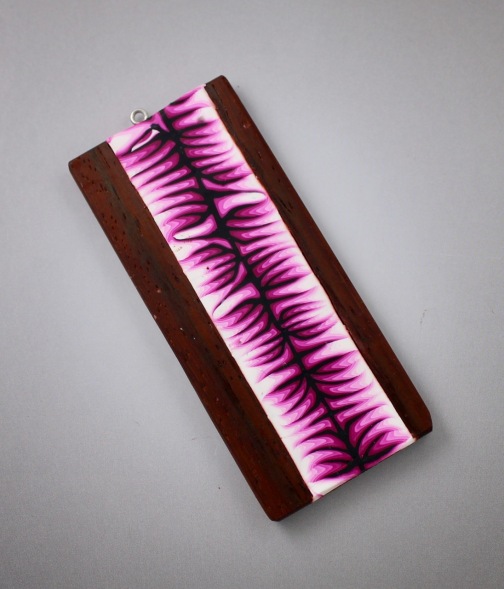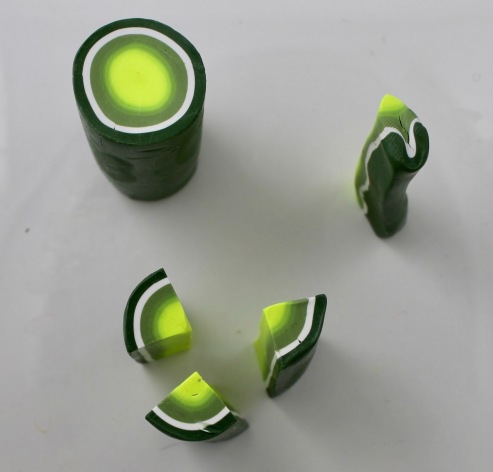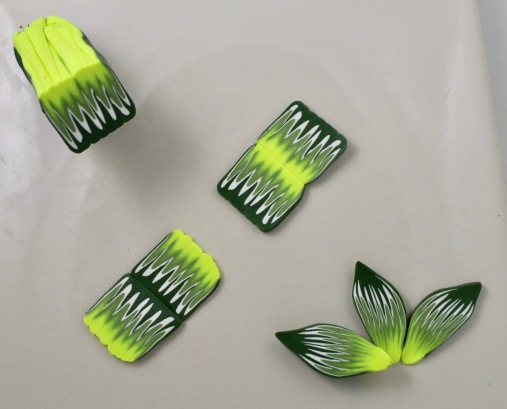Yes, I am playing with words. I plan to share a little tutorial with you as well as tute my own horn!!
I recently had the opportunity to do a demo for a joint meeting of the Palmetto/Sarasota Polymer Clay Guild and the Tarpon Springs, Florida Guild.
What a great bunch of gals . . . . . friendly, creative, and generous!! And they put out a pot luck spread for lunch that was an unexpected surprise!
I was demo’ing how to use polymer clay in the wooden components designed by Banyan Bay Studios. Here is a few of the designs they come up with.
As part of the demo there were some questions on a particular cane I had used on one of my sample pieces.

It is super simple, very forgiving and can be used in a number of ways. But let me be clear . . . . . I AM NOT THE INVENTOR OF THIS CANE!! It can be found throughout the polymer community and I am not even sure who to credit with its origination (Nan Roche, Donna Kato??).
You start by building a bullseye cane that is basically a cylinder of clay covered in concentric circles of color (solid colors or skinner blends of color). It is a basic that everyone should know and is the basis of so many more canes and designs!
Once the bullseye cane is built you cut it lengthwise in quarters.
You take each quarter and push the edges of the clay up while keeping the point of the internal color. (clear as mud, right?!?!). After this step, it doesn’t look pretty, I know, but keep going!

You then combine the four quarters and continue to compress and lengthen (or reduce your cane).
Cut and combine the four quarters one more time! Compress and lengthen (reduce) the cane to the desired size. The size and point where you say “I’m done” is completely your decision. There are no hard-fast rules here.
When creating a veneer from this cane you can combine slices in several ways. Create organic ‘flames’ coming from a center spine. This cane can be shaped into a petal and be the start of a flower. This cane can be combined with others in building more complex kaleidoscope canes.

Honestly, the simple bullseye cane is an un-sung hero in polymer clay and can be used for so many more designs, or as a building block or as accents. The colors you choose, whether to use solid blocks of color, a skinner blend or translucent will all change the look . . . . dramatically! But it is still a bullseye cane! Here are some other examples.
I had a bullseye cane in my stash that I used to demo a butt-join as I wrapped color around it. It was not really going to ‘be’ anything. Until someone said “what would that look like if you cut it up?”. So we gave it a try!
By the way, (this is the tooting my own horn part) if you are considering attending Bead and Button in June (go here to preview all the classes). I have 5 classes to choose from. Registration is open and I am pleased that they are filling up, its going to be fun!
























I applaud your tuting your own horn!!! Thanks for including Banyan Bay Studio in that tune!!! It was a great class and you are a very talented and giving teacher!!! Rock on!!
LikeLike
Very cool!
LikeLike
I liked seeing the steps of the cane and the amazing things that can happen. Do I need a new interest????
LikeLike
Your energy is inspiring!
LikeLike
Is there any guild or classes in The Davenport area (near Disney)? I just retired here from Atlanta and I would love to learn.
LikeLike
Annette you are in luck! There is the Orlando Area Polymer Clay Guild (www.oapcguild.com). They host the annual polymer clay retreat called Fandango the first week of May. I am teaching at Fandango 2019, hope to see you there!!
LikeLike
Thank you for this great tute! My head is now spinning!
LikeLike
Enjoy!!
LikeLike